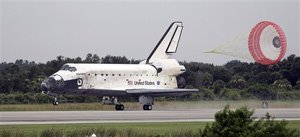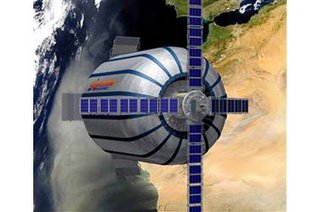
The Space Shuttle Discovery landed safely.
Discovery landed at Kennedy Space Center at 9:14 a.m. in only the second shuttle flight since the 2003 Columbia disaster killed seven astronauts.I guess that's what really counts. Compared to last time, it was a lot less scary.
"Welcome back, Discovery, and congratulations on a great mission," Mission Control told shuttle commander Steven Lindsey after Discovery rolled to a stop.
"It was a great mission, a really great mission, and enjoyed the entry and the landing," Lindsey replied.
The smooth landing was sure to leave NASA officials jubilant, after conquering the chronic threat of foam chunks that break off the external fuel tank during launch - still a problem, but not a serious one in this mission.
The shuttle came in from the south, swooping over the Pacific, Yucatan Peninsula, Gulf of Mexico and across Florida to cap a 5.3-million-mile journey that began on the Fourth of July.
A last-minute buildup of clouds led NASA to switch the shuttle's direction for landing. By the time Discovery approached, it was so cloudy, Lindsey couldn't spot the runway until about a minute before landing.
A couple of minutes out, NASA made a racket to keep birds out of the way of the approaching spacecraft. Car horns blared, and the sound of gunshots and firecrackers erupted.
At touchdown, shouts and whistles came from the few hundred astronauts' relatives and space center workers at the runway. "It's exciting to see the shuttle back," said astronaut Scott Kelly, the identical twin brother of Discovery's co-pilot, Mark Kelly.
"We're back on track with maybe flying the shuttle regularly here starting again in August."
Atlantis is up next with a crew poised to carry out assembly of the international space station, a task put on the back burner after Columbia.
Hotel Orbitalia? Hotel Balloonia?

A private consortium is trying to build an inflatable object to float up to Low Earth Orbit. It's a going to be a hotel. Here's the article.
Bigelow Aerospace’s Genesis 1 module activated its compressed air tanks to inflate the skin as planned, and is now sending back low-res photos to earth.Clearly, the space race has now been privatised.
The concept of an inflatable craft was conceived by Nasa in the 60s, and is much cheaper than standard spaceships as it takes up less room on the launch vehicle.
The only inhabitants of the 15ft by 8ft module are cockroaches, but the company is planning two more missions over the next year and believes a full-sized version for humans could be ready by 2010.
Fears that a giant bouncy castle might be a little prone to being punctured by space debris are apparently unfounded – the walls contain Kevlar, which is used in bullet proof vests, and the internal temperature is said to be a pleasant 26 degrees.
Founder Robert Bigelow is also trying to stoke up competition by launching ‘America’s Space Prize’, which is offering $50 million to any US company that can create a craft that can take 5 people into space. Looks like long weekends in space might be on the cards soon.
Battery Operated

This is a battery operated aircraft. That's right.
This aircraft flew 59 seconds for 391m using 160 A batteries, recording a maximum altitude of 5,2m. It spans 31m, and weighs 54kg. It was flown by Tomohiro Kamiya of Tokyo as part of a University project.
The craft was sponsored by Matsushita Electric, othrwise known to us as Panasonic. I guess they brought the batteries.

No comments:
Post a Comment